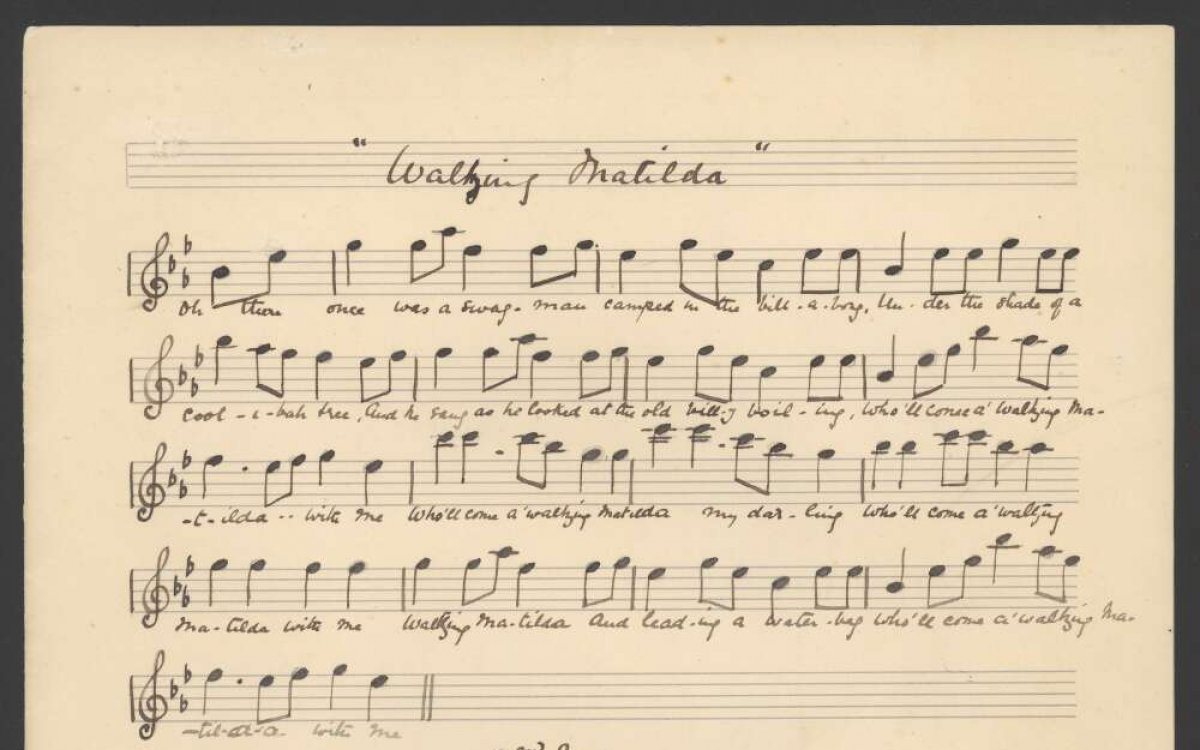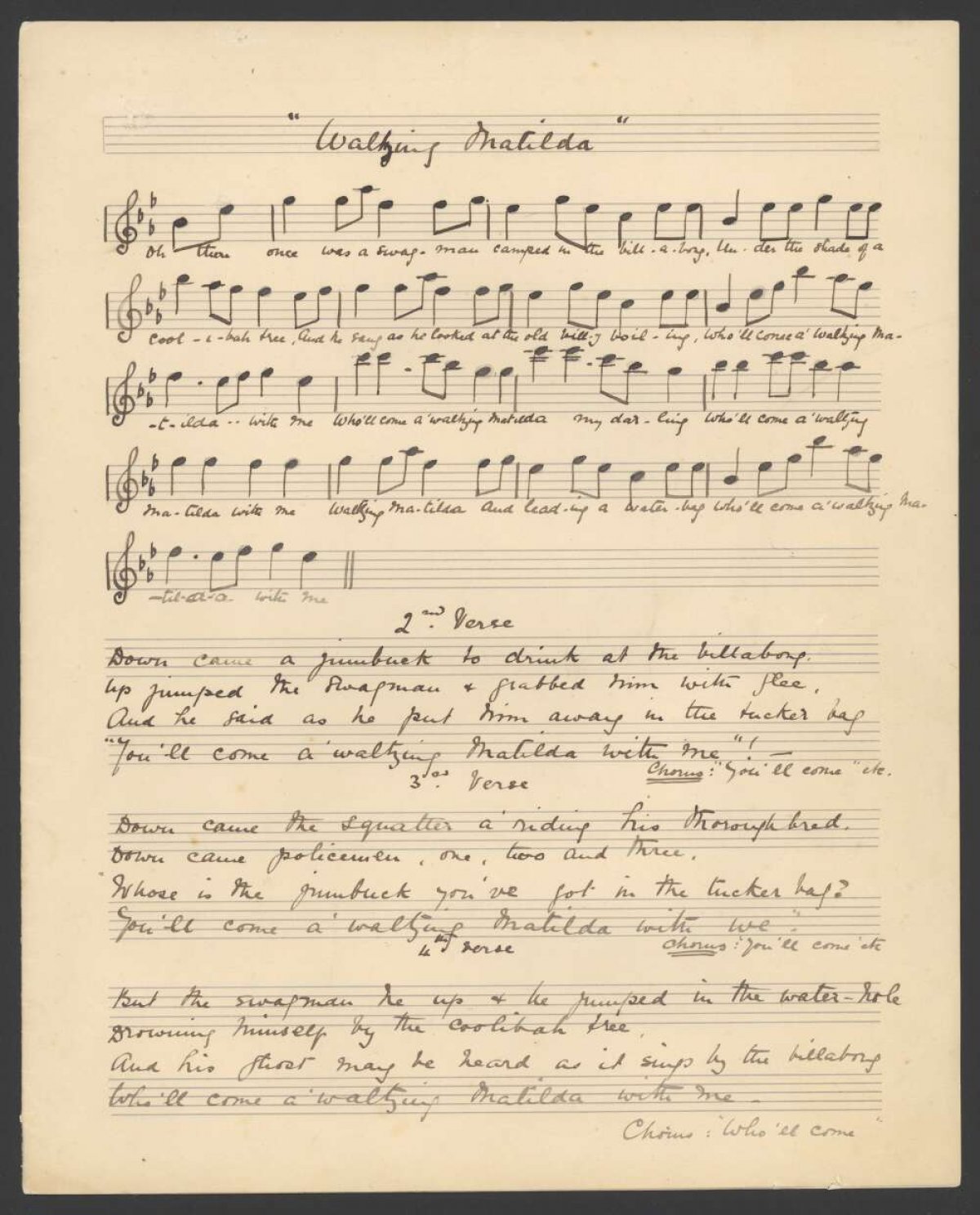Waltzing Matilda is recognized as Australia’s most popular folk song. Its words were written by Andrew Barton ‘Banjo’ Paterson (1864‒1941) and its melody was adapted from a Scottish folk song, Thou Bonnie Wood of Craigielea. The song was played by Christina Rutherford MacPherson (1864‒1936) in Paterson’s company at an after-dinner gathering at Dagworth Station near Winton, Queensland, in 1895.
The meaning of the song’s lyrics is the subject of much discussion and speculation. While Paterson never confirmed its meaning, it is widely accepted that the song is linked to the turbulence generated by the 1894 shearer’s strike and the violence that erupted at Dagworth Station in September of that year.
The swagman hero of the song is thought to be modelled on Samuel ‘Frenchy’ Hoffmeister, a shearer who took part in the Dagworth riots and who was found dead near a billabong in mysterious circumstances. Paterson’s song quickly spread around the district and the country. It came to represent the independence of the itinerant bush workers and, consequently, the spirit of Australian independence and a growing sense of national identity.
The National Library of Australia holds the original notated version of MacPherson’s adaptation, as well as a letter by MacPherson, explaining the origins of the song.

http://nla.gov.au/nla.obj-224076484 taken from Macpherson, Christina Rutherford. & McCall McCowan, Joan. (1900). Papers relating to the song "Waltzing Matilda",. http://nla.gov.au/nla.obj-224075208
1. With your students, read or sing the original text from Christina MacPherson’s notated manuscript of Waltzing Matilda. (You may like to read the text to the class, or read or sing the song together.)
WALTZING MATILDA
Oh there once was a swag man camped in the billabong,
Under the shade of a coolibah tree;
And he sang as he looked at the old billy boiling
‘Who'll come a Waltzing Matilda with me?’
Who'll come a Waltzing Matilda my darling,
Who'll come a Waltzing Matilda with me?
Waltzing Matilda, and leading a water bag;
Who'll come a Waltzing Matilda with me?
Down came a jumbuck to drink at the billabong,
Up jumped the swagman and grabbed him with glee;
And he said as he put him away in the tucker bag
‘You'll come a Waltzing Matilda with me!’
Who'll come a Waltzing Matilda my darling,
Who'll come a Waltzing Matilda with me?
Waltzing Matilda, and leading a water bag;
Who'll come a Waltzing Matilda with me?
Down came the squatter a-riding his thoroughbred,
Down came policemen, one, two and three,
‘Whose is the jumbuck you've got in your tucker bag?
You'll come a Waltzing Matilda with me!’
Who'll come a Waltzing Matilda my darling,
Who'll come a Waltzing Matilda with me?
Waltzing Matilda, and leading a water bag;
Who'll come a Waltzing Matilda with me?
But the swagman he up & he jumped in the waterhole,
Drowning himself by the coolibah tree;
And his ghost may be heard as it sings by the billabong
‘Who'll come a Waltzing Matilda with me?’
Who'll come a Waltzing Matilda my darling,
Who'll come a Waltzing Matilda with me?
Waltzing Matilda, and leading a water bag;
Who'll come a Waltzing Matilda with me?
WALTZING MATILDA
Oh there once was a swag man camped in the billabong,
Under the shade of a coolibah tree;
And he sang as he looked at the old billy boiling
‘Who'll come a Waltzing Matilda with me?’
Who'll come a Waltzing Matilda my darling,
Who'll come a Waltzing Matilda with me?
Waltzing Matilda, and leading a water bag;
Who'll come a Waltzing Matilda with me?
Down came a jumbuck to drink at the billabong,
Up jumped the swagman and grabbed him with glee;
And he said as he put him away in the tucker bag
‘You'll come a Waltzing Matilda with me!’
Who'll come a Waltzing Matilda my darling,
Who'll come a Waltzing Matilda with me?
Waltzing Matilda, and leading a water bag;
Who'll come a Waltzing Matilda with me?
Down came the squatter a-riding his thoroughbred,
Down came policemen, one, two and three,
‘Whose is the jumbuck you've got in your tucker bag?
You'll come a Waltzing Matilda with me!’
Who'll come a Waltzing Matilda my darling,
Who'll come a Waltzing Matilda with me?
Waltzing Matilda, and leading a water bag;
Who'll come a Waltzing Matilda with me?
But the swagman he up & he jumped in the waterhole,
Drowning himself by the coolibah tree;
And his ghost may be heard as it sings by the billabong
‘Who'll come a Waltzing Matilda with me?’
Who'll come a Waltzing Matilda my darling,
Who'll come a Waltzing Matilda with me?
Waltzing Matilda, and leading a water bag;
Who'll come a Waltzing Matilda with me?
Next, listen to, or read, the version of Waltzing Matilda that students are more familiar with. Use the following questions to explore the poem with your students in a class discussion:
- How is the original song different from the song you know?
- Why do you think the song has changed over time?
- Why do you think MacPherson’s handwritten copy of the song is considered a national treasure?
- What is the storyline of this song?
- What does the phrase 'Waltzing Matilda' mean?
- What is a jumbuck? Why might the swagman have captured the jumbuck?
- In colonial Queensland, law enforcement was the responsibility of the military. During the shearers’ strikes of the 1890s, troops travelled in small groups. How many troopers do the lyrics suggest travelled together?
- (Show your students the online digitised version of the song.) How old is this document? How can you tell?
- List the slang words in the lyrics that are no longer in regular use.
- What does Waltzing Matilda symbolise for Australians today?
2. Invite students to create an illustration for Waltzing Matilda that reflects their personal response to the words and music, and to the song’s place in Australia’s national identity.
3. Ask students to research the shearer’s riot at Dagworth Station in 1894. Show students (or encourage them to independently research) 1894 newspaper articles from Trove that report on the death of Samuel ‘Frenchy’ Hoffmeister, the man about whom Waltzing Matilda is said to be written. Based on the newspaper reports and the song’s lyrics, ask students to form their own opinion of events surrounding Hoffmeister’s death, and to write a newspaper article about or obituary for Hoffmeister.
4. Ask students to write a song that captures how they feel about living in Australia.
Other Treasures sources that relate to the concepts explored in this source include: The poet of Australia and Documenting Federation.
